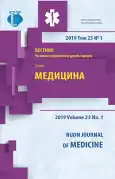EFFECT OF CONNECTIVE INSUFFICIENCY AND SIZES OF MEDIAN HERNIAS ON BEFORE AND POSTOPERATIVE FUNCTION OF THE ABDOMINAL MUSCLE
- 作者: Railianu R.I.1, Podoliniy G.I.1, Marshaluk A.V.1
-
隶属关系:
- Shevchenko State University of Pridnestrovie
- 期: 卷 23, 编号 1 (2019)
- 页面: 40-53
- 栏目: SURGERY
- URL: https://journal-vniispk.ru/2313-0245/article/view/345301
- DOI: https://doi.org/10.22363/2313-0245-2019-23-1-40-53
- ID: 345301
如何引用文章
全文:
详细
The article analyzes the results of electromyography of the abdominal muscles in 189 patients with median postoperative hernia of the anterior abdominal wall of different sizes before and after the combined methods of hernioplasty, including considering the level of connective tissue failure. In the preoperative period, electromyography was performed in 69 (36,6%), after combined hernioplasty, 120 (63,4%) patients. The patients were divided into a group of 161 (85,1%) patients with clinically significant or histologically confirmed connective tissue insufficiency and into a group of 28 (14,9%) patients without it. The distribution of patients in the examination groups was carried out using an original method of assessing the degree of deviation of collagen fibers from the projection of the Langer lines in microscopic specimens of the skin areas excised during the operation and based on the results of a retrospective analysis of case histories with determination of the intraoperative adhesions of the adhesions in the abdominal cavity or hernial sac. In the formed groups, we studied the amplitude, frequency, front and area of electromyograms obtained from the direct and lateral muscles of the anterior abdominal wall. It was found that in patients with median postoperative hernias, mesenchymal dysplasia was the main reason for the decrease in functional activity and the imbalance of forces between the direct and lateral abdominal muscles. Optimal restoration of electroactivity of the abdominal muscles after combined hernioplasty occurred among patients without clinically significant connective tissue insufficiency. When reaching a giant postoperative hernia of gigantic size in patients with a clinically significant level of connective tissue dysplasia, the functioning of the abdominal muscles decreased by 26%, and in patients without it only by 15%. The pathology of collagen in skin grafts excised during surgery was detected in 91,5% of patients with mid-incisional hernias.
作者简介
R. Railianu
Shevchenko State University of Pridnestrovie
编辑信件的主要联系方式.
Email: railianu.radu@yandex.com
SPIN 代码: 2736-4592
Moldova, Tiraspol
G. Podoliniy
Shevchenko State University of Pridnestrovie
Email: railianu.radu@yandex.com
Moldova, Tiraspol
A. Marshaluk
Shevchenko State University of Pridnestrovie
Email: railianu.radu@yandex.com
Moldova, Tiraspol
参考
- Zvorygina M.A., Khafizova A.F. Hernia of the anterior abdominal wall as a consequence of connective tissue dysplasia. Journal of Synergy of Sciences. 2017; 1 (17): 894-898.
- Sadizhov N.M. To the evaluation of the results of surgical treatment of hernia of the anterior abdominal wall with connective tissue dysplasia syndrome: Autor’s abstract. dis.. cand. medical sciences. Tver, 2017. 23 p.
- Derkach N.N. Surgical treatment and prevention of postoperative abdominal hernias with simultaneous open and laparoscopic interventions: Dis.. cand. medical sciences. Simferopol, 2017. 182 p.
- Jorgenson E., Makki N., Shen L., Chen D.C., Tian C, Eckallar W.L., Hinds D., Ahitnv N., Avins A. A genome - wide association study identified four novel susceptibility loci underlying inguinal hernia. J. Nature Communications. 2015; 6: 10130. doi: 10.1038/ncomms1030.
- Oberg S., Anderesen K., Rosenberg J. Etiology of inguinal hernias: a comprehensive Review. J. Frontiers in Surgery. 2017; 4: 52. doi: 10.3389/fsurg.2017.00052. eCollection2017.
- Ivanov I.S. The strategy of choosing the method of plastics hernia of the anterior abdominal wall: an experimentally-clinical study: Autor’s abstract. dis.. doctor of medical sciences. Kursk, 2013. 45 p.
- Plechev V.V., Kornilaev P.G., Feoktistov D.V., Shavaleev R.R., Khakamov T.Sh. Morphological assessment of the effectiveness of the method of preventing wound complications during implantation hernioplasty. Medical journal of Bashkortostan. 2014; V. 9 (5): 41-44.
- Sobennikov I.V. The effect of surgical treatment of patients with inguinal hernia on testicular function: Dis.. cand. medical sciences. Ryazan, 2017. 136 p.
- Belokonev V.I., Ponomareva Yu.V., Pushkin S.Yu., Kovaleva Z.V., Gubskij V.M., Terexin A.A. Anterior prosthetic hernioplasty in a combined way for large and giant ventral hernias. Surgery. Journal them. N.I. Pirogov. 2018; V. 5: 45-50.
- Vinnik Yu.S., Chajkin A.A., Nazar`yancz Yu.A., Petrushko S.I. A modern view on the problem of treating patients with postoperative ventral hernias. Siberian Medical Review. 2014; V. 6 (90): 5-13.
- Ermolov A.S., Koroshvili V.T., Blagovestnov D.A., Yarcev P.A., Shlyaxovskij I.A. Postoperative abdominal hernia: prevalence and etiopathogenesis. Surgery. 2017; V. 5: 76-82.
- Ennis L.S., Young J.S., Gampper T.J., Drake D.B. The “open-book” variation of component separation for repair of massive midline abdominal wall hernia. Am. Surg. 2003; V. 69(9): 733-742.
- Punjani R., Shaikh I., Soni V. Component Separation Technique: An Effective Way of Treating Large Ventral Hernia. Indian J. Surg. 2015: V. 77 (suppl 3): 1476-1479.
- Burcharth J., Pommergaard H.C., Bisgaard T., Rosenberg J. Patient-related risk factors for recurrence after inguinal hernia repair a systematic review and meta-analysis of observational studies. J. Surgical innovation. 2015; 22 (3): 303-317.
- Gubov Y.P., Rybachkov V.V., Blandinsky V.F., Sokolov S.V., Sadizhov N.M. Clinical aspects of a syndrome of an undifferentiated dysplasia of a connecting tissue at hernias of a forward abdominal wall. The Magazine Modern problems of science and education. 2015; 1 (part 1). URL: https://science-education.ru/ru/article/ view?id=17863.
- Shavaleev R.R. A comprehensive method for the diagnosis, treatment and prevention of postoperative ventral hernias, combined with peritoneal commissural disease: Autor’s abstract. dis.. doctor of medical sciences. Ufa, 2005. 52 p.
- Gobedzhishvili V.V. Prevention of postoperative intra-abdominal adhesions in patients with intestinal obstruction of non-tumor genesis: Autor’s abstract. dis.. cand. medical sciences. Stavropol, 2013. 20 p.
- Gubish A.V. The use of synthetic and biotechnological materials for hernioplasty of hernias of the anterior abdominal wall: Dis.. cand. medical sciences. Krasnodar, 2017. 122 p.
- Mikhin I.V., Kukhtenko Yu.V., Panchishkin A.S. Large and giant postoperative ventral hernia: the possibilities of surgical treatment (literature review). Herald of Volgograd state medical University. 2014; 2 (50): 8-16.
- Botezatu A.A. Combined plastic hernia of the anterior abdominal wall using an autodermal graft: Autor’s abstract. dis.. doctor of medical sciences. Moscow, 2013. 38 p.
补充文件









